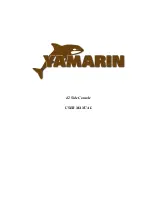
5-4
Section 5 • Care & Maintenance
R
150 Montauk
A bare hull is one that has never been painted.
Preparation is key to successful hull painting. Take
extra care and time in preparation before proceeding
to paint.
Begin by scrubbing the surface thoroughly with a stiff
brush using an all-purpose marine soap and water
to remove loose dirt and contamination. Flush with
fresh water to remove all soap residue.
The gelcoat will have to be dewaxed of mold release
wax before sanding can begin, otherwise the wax
will be dragged into the scratches and will reduce
the adhesion properties of the paint.
Remove any mold release wax that may be present
using fiberglass surface prep solvent and a scrub
pad. Scrub only a few square feet at a time. Flush
with fresh water. If the water beads up or separates,
continue scrubbing the surface. When the water
sheets off, the wax contaminate has been removed.
After the dewaxing is complete, application of a primer
coat is recommended. Pay close attention to scratches,
nicks and dings in the surface. If necessary, fill any
repair areas with a watertight epoxy filler. After filler
is cured, sand with 80 grit paper until smooth. Remove
the sanding residue using a fiberglass solvent wash.
The paint can be applied after sanding and cleaning
is complete. Follow the paint manufacturer’s
recommendations for application.
Make sure that there is enough paint left to cover
areas that were not accessible, (slings, jack stands
etc.) and paint accordingly. Follow the
paint
manufacturer’s recommendation for do’s and dont’s
after the painting is complete.
Bottom
Painting a Pre-Painted Hull
If the hull bottom is already painted, you must be
sure to test the paint’s adhesion to the already painted
surface. If the paints are incompatible, the new paint
will not adhere to the hull bottom or the paint will
“lift
” the old paint.
NEVER
apply paint without first
preparing the old painted surface following the paint
manufacturer’s recommendations.
Follow the paint manufacturer’s recommendation for
applying the paint. Humidity and weather will play
a role in how and when the paint is applied. Several
thin layers are better than one thick layer.
To determine the waterline, you will need to place the
boat in water with a full load of fuel and gear. Mark
the waterline and measure above the marked line
1 to 3 inches for placement of the tape line.
Rubrail Care
The rubrail on your boat is constructed of an injected
high density
PVC vinyl
material which laboratory
tests have proven to be highly resistant to staining,
fading and cracking.
As resilient as this material is, you still need to follow
some basic maintenance precautions.
General maintenance requires a thorough cleaning
with mild soap & water.
DO NOT
use any cleaning
agents which contain chemicals.
Although the outer shell is tough and durable, there
is a chance that it can be breached. Use care when
docking or exposing the rubrail to conditions which
may cause damage such as docking against heavily
barnacle-encrusted pilings.
Some tears (cleanly sliced) can be repaired with a
“Super Glue” type product.
Thoroughly clean and dry the affected area. Apply
glue and hold the surfaces together.
Areas which have been torn or are affected by heavy
abrasion will have to have the damaged section
replaced. Please see your Boston Whaler
®
dealer for
this type of repair.
Cleaning Fiberglass & Non-Skid
NOTICE
NEVER use abrasive cleaners, detergents or soft
scrub type cleaners to wash your boats surfaces.
NEVER use abrasive pads, brushes or sponges
to attempt to remove stubborn stains.
NEVER use strong solvents or detergents which
contain chlorine.
To protect your deck and non-skid areas from the
deteriorating affects of the sun, oxidation, water
Содержание 150 Montauk
Страница 1: ...150 Montauk Owner s Manual ...
Страница 73: ...3 10 150 Montauk Section 3 Systems Components Overview Operation R THIS PAGE INTENTIONALLY LEFT BLANK ...
Страница 78: ...4 5 150 Montauk Section 4 Electrical System Electrical Harness sheet 1 Fig 4 5 1 DC ENG TO NAV LIGHT ...
Страница 79: ...4 6 150 Montauk Section 4 Electrical System R Electrical Harness sheet 2 Fig 4 6 1 STEREO FUSE BLOCK ...
Страница 80: ...4 7 150 Montauk Section 4 Electrical System Electrical Harness sheet 3 Fig 4 7 1 ...
Страница 82: ...4 9 150 Montauk Section 4 Electrical System Trolling Motor Schematic Option Fig 4 9 1 6026 07 401_2_E ...
Страница 83: ...4 10 150 Montauk Section 4 Electrical System R Stereo Schematic Option Fig 4 10 1 6026 07 401_3_E ...
Страница 94: ...5 11 Section 5 Care Maintenance R 150 Montauk Reinforcement Location Diagram ...









































